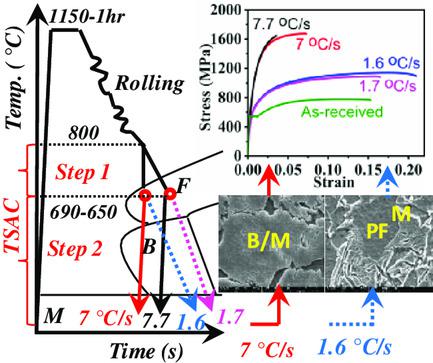当前位置:
X-MOL 学术
›
Steel Res. Int.
›
论文详情
Our official English website, www.x-mol.net, welcomes your
feedback! (Note: you will need to create a separate account there.)
On a New Two‐Step Air Cooling Method Following Thermomechanically Controlled Rolling: Microstructural Evolution and Mechanical Properties of a High‐Strength Multiphase Medium Carbon Microalloyed Steel
Steel Research International ( IF 1.9 ) Pub Date : 2020-12-23 , DOI: 10.1002/srin.202000563 Hari Srinivasa Rao Magham 1 , Nandakumar Maheswari 2 , Kumar Dinesh 2 , Lakshmanan Vijayaraghavan 1 , Shanmugam Sankaran 2 , Kuppuswamy Anantha Padmanabhan 3
Steel Research International ( IF 1.9 ) Pub Date : 2020-12-23 , DOI: 10.1002/srin.202000563 Hari Srinivasa Rao Magham 1 , Nandakumar Maheswari 2 , Kumar Dinesh 2 , Lakshmanan Vijayaraghavan 1 , Shanmugam Sankaran 2 , Kuppuswamy Anantha Padmanabhan 3
Affiliation

|
A new two‐step air cooling (TSAC) process following finish rolling is developed for producing a multiphase (ferrite–bainite–martensite [FBM]) microstructure in a medium carbon V‐microalloyed steel without any post‐forming heat treatment. In TSAC, step 1, designated as natural air cooling (NAC − 4.2 and 5.1 °C s−1); step 2, representing two different cooling methods, namely, forced air cooling (FAC − 7 and 7.71 °C s−1) and controlled air cooling (CAC − 1.63 and 1.75 °C s−1), are adopted from two critical transformation temperatures. Both cooling methods result in multiphase (FBM) microstructures which consist of polygonal ferrite (PF), bainite (B), martensite (M), retained austenite (RA), and vanadium carbonitride (V (C, N)) precipitates. In both steels, the fraction of RA lies in the range of 8–11%. The FAC steel exhibits a tensile strength (TS) in the range of 1652–1671 MPa and ≈4–7% of total elongation, whereas the CAC steel displays a maximum TS of 1100 MPa and 17% elongation at fracture. The FAC steel exhibits a higher work‐hardening rate compared to a CAC steel. A transmission electron microscopy (TEM) analysis of tested samples reveals that stable RA plays a crucial role in improving the work‐hardening capability of these multiphase steels.
中文翻译:

热力学控制轧制后的新型两步空冷方法:高强度多相中碳微合金钢的组织演变和力学性能
精轧后开发了一种新的两步空气冷却(TSAC)工艺,用于在中碳V微合金钢中进行多相(铁素体-贝氏体-马氏体[FBM])微结构,而无需进行任何后成形热处理。在TSAC的步骤1中,指定为自然风冷(NAC-4.2和5.1°C s -1);步骤2代表两种不同的冷却方法,即强制风冷(FAC − 7和7.71°C s -1)和受控风冷(CAC − 1.63和1.75°C s -1),是从两个临界转化温度采用的。两种冷却方法均导致多相(FBM)微观结构,该组织由多边形铁素体(PF),贝氏体(B),马氏体(M),残余奥氏体(RA)和碳氮化钒(V(C,N))沉淀物组成。在两种钢中,RA的分数都在8-11%的范围内。FAC钢的拉伸强度(TS)在1652–1671 MPa范围内,占总伸长率的≈4-7%,而CAC钢的最大TS则为1100 MPa,断裂时的伸长率为17%。与CAC钢相比,FAC钢具有更高的加工硬化率。对测试样品的透射电子显微镜(TEM)分析表明,稳定的RA在提高这些多相钢的加工硬化能力中起着至关重要的作用。
更新日期:2020-12-23
中文翻译:

热力学控制轧制后的新型两步空冷方法:高强度多相中碳微合金钢的组织演变和力学性能
精轧后开发了一种新的两步空气冷却(TSAC)工艺,用于在中碳V微合金钢中进行多相(铁素体-贝氏体-马氏体[FBM])微结构,而无需进行任何后成形热处理。在TSAC的步骤1中,指定为自然风冷(NAC-4.2和5.1°C s -1);步骤2代表两种不同的冷却方法,即强制风冷(FAC − 7和7.71°C s -1)和受控风冷(CAC − 1.63和1.75°C s -1),是从两个临界转化温度采用的。两种冷却方法均导致多相(FBM)微观结构,该组织由多边形铁素体(PF),贝氏体(B),马氏体(M),残余奥氏体(RA)和碳氮化钒(V(C,N))沉淀物组成。在两种钢中,RA的分数都在8-11%的范围内。FAC钢的拉伸强度(TS)在1652–1671 MPa范围内,占总伸长率的≈4-7%,而CAC钢的最大TS则为1100 MPa,断裂时的伸长率为17%。与CAC钢相比,FAC钢具有更高的加工硬化率。对测试样品的透射电子显微镜(TEM)分析表明,稳定的RA在提高这些多相钢的加工硬化能力中起着至关重要的作用。










































 京公网安备 11010802027423号
京公网安备 11010802027423号